Early Gapping and Platoon Merging Strategies for Autonomous Vehicles using Local Controllers
Abstract
1. Introduction
Merge Methods
- When driving as platoons, AVs allow smaller gaps;
- AVs can merge smoothly by accurately planning and calculating ahead;
- AVs are obedient and are bound to obey precursory behavioral profiles;
- AVs are indifferent to fairness on the road.
2. Methods
2.1. Nomenclature
2.2. Gap Profile Method
- The current gap should be larger than the previous gap, i.e., .
- The gap should be larger than a safety gap gs, i.e., .
2.3. Gap Profile Types
2.4. Simulation Parameters
3. Results
3.1. Vehicle Dynamics in a Position-Time Space
3.2. Effect of Inlet Density
3.3. Traffic Flow as a Function of Gap Profile
3.4. Merging Success as a Function of Platoon Sizes
4. Discussion
5. Conclusions
Author Contributions
Funding
Conflicts of Interest
References
- Anastassov, A.; Jang, D.; Giurgiu, G. Driving speed profiles for autonomous vehicles. In Proceedings of the 2017 IEEE Intelligent Vehicles Symposium (IV), Los Angeles, CA, USA, 11–14 June 2017; pp. 1446–1451. [Google Scholar]
- Talebpour, A.; Mahmassani, H.S.; Hamdar, S.H. Modeling lane-changing behavior in a connected environment: A game theory approach. Transp. Res. Procedia 2015, 7, 420–440. [Google Scholar] [CrossRef]
- Wang, J.; Lv, W.; Jiang, Y.; Qin, S.; Li, J. A multi-agent based cellular automata model for intersection traffic control simulation. Phys. A Stat. Mech. Its Appl. 2021, 584, 126356. [Google Scholar] [CrossRef]
- Lin, D.; Li, L.; Jabari, S.E. Pay to change lanes: A cooperative lane-changing strategy for connected/automated driving. Transp. Res. Part C Emerg. Technol. 2019, 105, 550–564. [Google Scholar] [CrossRef]
- Lu, N.; Cheng, N.; Zhang, N.; Shen, X.; Mark, J.W. Connected vehicles: Solutions and challenges. IEEE Internet Things J. 2014, 1, 289–299. [Google Scholar] [CrossRef]
- Liu, X.; Goldsmith, A.; Mahal, S.S.; Hedrick, J.K. Effects of communication delay on string stability in vehicle platoons. In Proceedings of the Intelligent Transportation Systems, Oakland, CA, USA, 25–29 August 2001; IEEE: Piscataway, NJ, USA, 2001; pp. 625–630. [Google Scholar]
- Talebpour, A.; Mahmassani, H.S. Influence of connected and autonomous vehicles on traffic flow stability and throughput. Transp. Res. Part C Emerg. Technol. 2016, 71, 143–163. [Google Scholar] [CrossRef]
- Shagdar, O.; Muhlethaler, P. Study on merging control supported by IEEE 802.11 p systems for highway environments. In Proceedings of the 2013 IFIP Wireless Days (WD), Velencia, Spain, 13–15 November 2013; IEEE: Piscataway, NJ, USA, 2013; pp. 1–4. [Google Scholar]
- Zhang, C.; Lin, X.; Lu, R.; Ho, P.H. RAISE: An efficient RSU-aided message authentication scheme in vehicular communication networks. In Proceedings of the 2008 IEEE International Conference on Communications, Washington, DC, USA, 25–27 September 2008; IEEE: Piscataway, NJ, USA, 2008; pp. 1451–1457. [Google Scholar]
- Krüger, T.-J.; Göhring, D.; Ulbrich, F. Graph-Based Speed Planning for Autonomous Driving. Ph.D. Dissertation, Free University of Berlin, Berlin, Germany, 2019. [Google Scholar]
- Liu, C.; Zhan, W.; Tomizuka, M. Speed profile planning in dynamic environments via temporal optimization. In Proceedings of the 2017 IEEE Intelligent Vehicles Symposium (IV), Los Angeles, CA, USA, 11–14 June 2017; IEEE: Piscataway, NJ, USA, 2017; pp. 154–159. [Google Scholar]
- Geller, S.; Avrahami, I.; Shvalb, N. Control of Autonomous Vehicles Flow Using imposed speed Profiles. J. Intell. Transp. Syst. 2021, 2021, 1–15. [Google Scholar] [CrossRef]
- Vaughan, C.; Cunningham, C.; Warchol, S.; Findley, D.; Carnes, C.; Sallade, S.; Kearns, B. The Effects of Late Lane Merges on Travel Times; North Carolina Department of Transportation, Institute for Transportation Research and Education North Carolina State University: Raleigh, NC, USA, 2018. [Google Scholar]
- Lammers, E.; Pigman, J.G.; Howell, B.; Kirk, A. Applicability of Zipper Merge Versus Early Merge in Kentucky Work Zones; University of Kentucky Transportation Center: Lexington, KY, USA, 2017. [Google Scholar]
- Baselt, D.; Knorr, F.; Scheuermann, B.; Schreckenberg, M.; Mauve, M. Merging lanes—fairness through communication. Veh. Commun. 2014, 1, 97–104. [Google Scholar] [CrossRef]
- Grillo, L.F.; Datta, T.K.; Hartner, C. Dynamic late lane merge system at freeway construction work zones. Transp. Res. Rec. 2008, 2055, 3–10. [Google Scholar] [CrossRef]
- Nishi, R.; Miki, H.; Tomoeda, A.; Yanagisawa, D.; Nishinari, K. Reversal of Travel Time between Zipper and Non-Zipper Mergings on Highway Traffic under the Existence of Vehicles Going Straight. SICE J. Control. Meas. Syst. 2011, 4, 43–49. [Google Scholar] [CrossRef]
- Bevly, D.; Cao, X.; Gordon, M.; Ozbilgin, G.; Kari, D.; Nelson, B.; Woodruff, J.; Barth, M.; Murray, C.; Kurt, A.; et al. Lane change and merge maneuvers for connected and automated vehicles: A survey. IEEE Trans. Intell. Veh. 2016, 1, 105–120. [Google Scholar] [CrossRef]
- Perry, F.; Raboy, K.; Leslie, E.; Huang, Z.; Van Duren, D. Dedicated Short-Range Communications Roadside Unit Specifications; United States Department of Transportation: Washington, DC, USA, 2017.
- Fang, Y.; Chu, F.; Mammar, S.; Zhou, M. Optimal lane reservation in transportation network. IEEE Trans. Intell. Transp. Syst. 2011, 13, 482–491. [Google Scholar] [CrossRef]
- Kanaris, A.; Kosmatopoulos, E.B.; Loannou, P.A. Strategies and spacing requirements for lane changing and merging in automated highway systems. IEEE Trans. Veh. Technol. 2001, 50, 1568–1581. [Google Scholar] [CrossRef]
- Helbing, D. Traffic and related self-driven many-particle systems. Rev. Mod. Phys. 2001, 73, 1067–1141. [Google Scholar] [CrossRef]
- Orosz, G. The Dynamics of Vehicular Traffic with Drivers’ Reaction Time Delay. Ph.D. Dissertation, University of Bristol, Bristol, UK, 2005. [Google Scholar]
- James, R.M.; Melson, C.; Hu, J.; Bared, J. Characterizing the impact of production adaptive cruise control on traffic flow: An investigation. Transp. B Transp. Dyn. 2019, 7, 992–1012. [Google Scholar] [CrossRef]
- Ntousakis, I.A.; Nikolos, I.K.; Papageorgiou, M. Optimal vehicle trajectory planning in the context of cooperative merging on highways. Transp. Res. Part C Emerg. Technol. 2016, 71, 464–488. [Google Scholar] [CrossRef]
- Suijs, L.; Wismans, L.; Krol, L.; van Berkum, E. Phantom jam avoidance through in-car speed advice. Transp. Res. Procedia 2015, 8, 227–236. [Google Scholar] [CrossRef][Green Version]
- Filzek, B.; Breuer, B. Distance behaviour on motorways with regard to active safety: A comparison between adaptive-cruise-control (ACC) and driver. In Proceedings of the International Technical Conference on Enhanced Safety of Vehicles, Gothenburg, Sweden, 8–11 June 2015; pp. 1–8. [Google Scholar]
- Vander Werf, J.; Shladover, S.; Miller, M.; Kourjanskaia, N. Effects of adaptive cruise control systems on highway traffic flow capacity. Transp. Res. Rec. 2002, 1800, 78–84. [Google Scholar] [CrossRef]
- Wu, X.; Liu, H.X. The Uncertainty of Drivers’ Gap Selection and its Impact on the Fundamental Diagram. Procedia-Soc. Behav. Sci. 2013, 80, 901–921. [Google Scholar] [CrossRef]
- Bokare, P.S.; Maurya, A.K. Acceleration-deceleration behaviour of various vehicle types. Transp. Res. Procedia 2017, 25, 4733–4749. [Google Scholar] [CrossRef]
- Brooks, R.M. Acceleration characteristics of vehicles in rural Pennsylvania. Analysis 2012, 1, 5–22. [Google Scholar]
- Long, G. Acceleration characteristics of starting vehicles. Transp. Res. Rec. 2000, 1737, 58–70. [Google Scholar] [CrossRef]
- Mehar, A.; Chandra, S.; Velmurugan, S. Speed and acceleration characteristics of different types of vehicles on multi-lane highways. Eur. Transp. 2013, 55, 1–12. [Google Scholar]
- Greibe, P. Braking Distance, Friction and Behavior; Denmark Trafitec Scion—DTU: Lyngby, Denmark, 2007; Available online: https://www.trafitec.dk/sites/default/files/publications/braking%20distance%20-%20friction%20and%20driver%20behaviour.pdf (accessed on 21 May 2022).
- Christensen, H.I.; Khan, A.; Pokutta, S.; Tetali, P. Approximation and online algorithms for multidimensional bin packing: A survey. Comput. Sci. Rev. 2017, 24, 63–79. [Google Scholar] [CrossRef]
- Subhanka, N. Impact of Level 3 Automated Vehicle Merging on 2-to-1 Lane Freeway. Master’s Thesis, University of Wisconsin-Madison, Madison, WI, USA, 2018. [Google Scholar]
- Nishi, R.; Miki, H.; Tomoeda, A.; Yanagisawa, D.; Nishinari, K. Inversion of flux between zipper and non-zipper merging in highway traffic. In Proceedings of the International Conference on Cellular Automata, Ascoli Piceno, Italy, 21–24 September 2010; pp. 619–624. [Google Scholar]

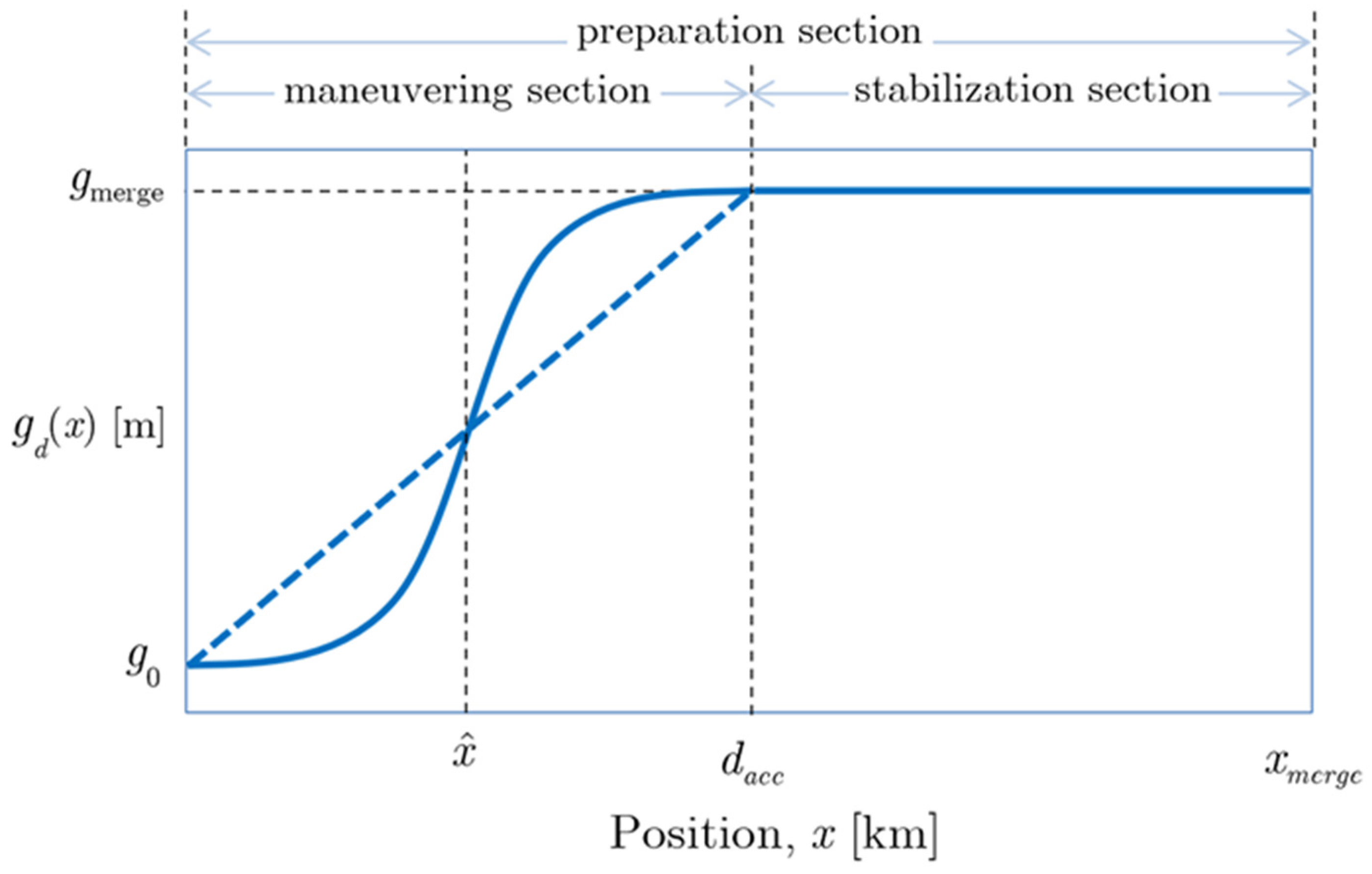
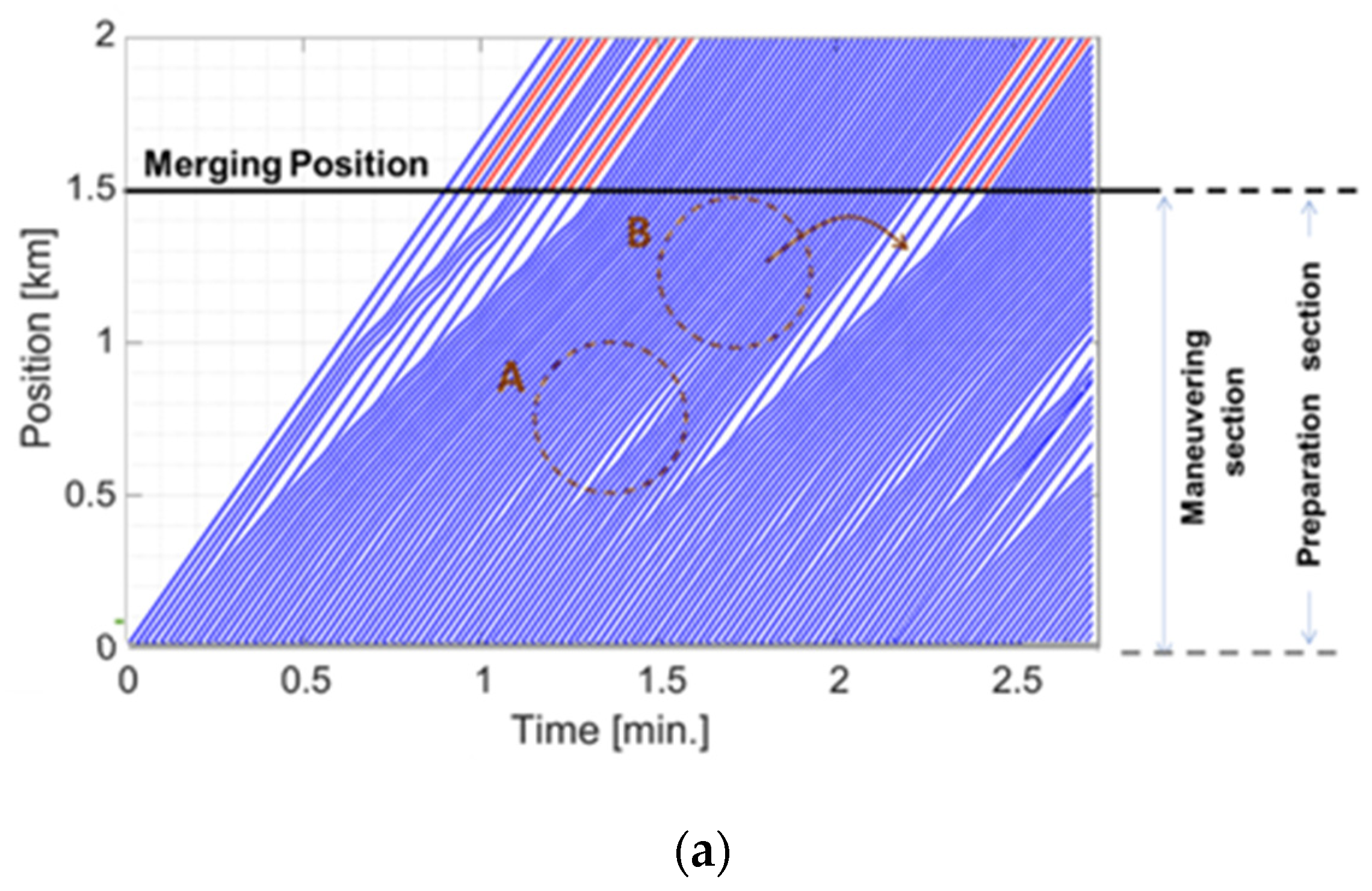
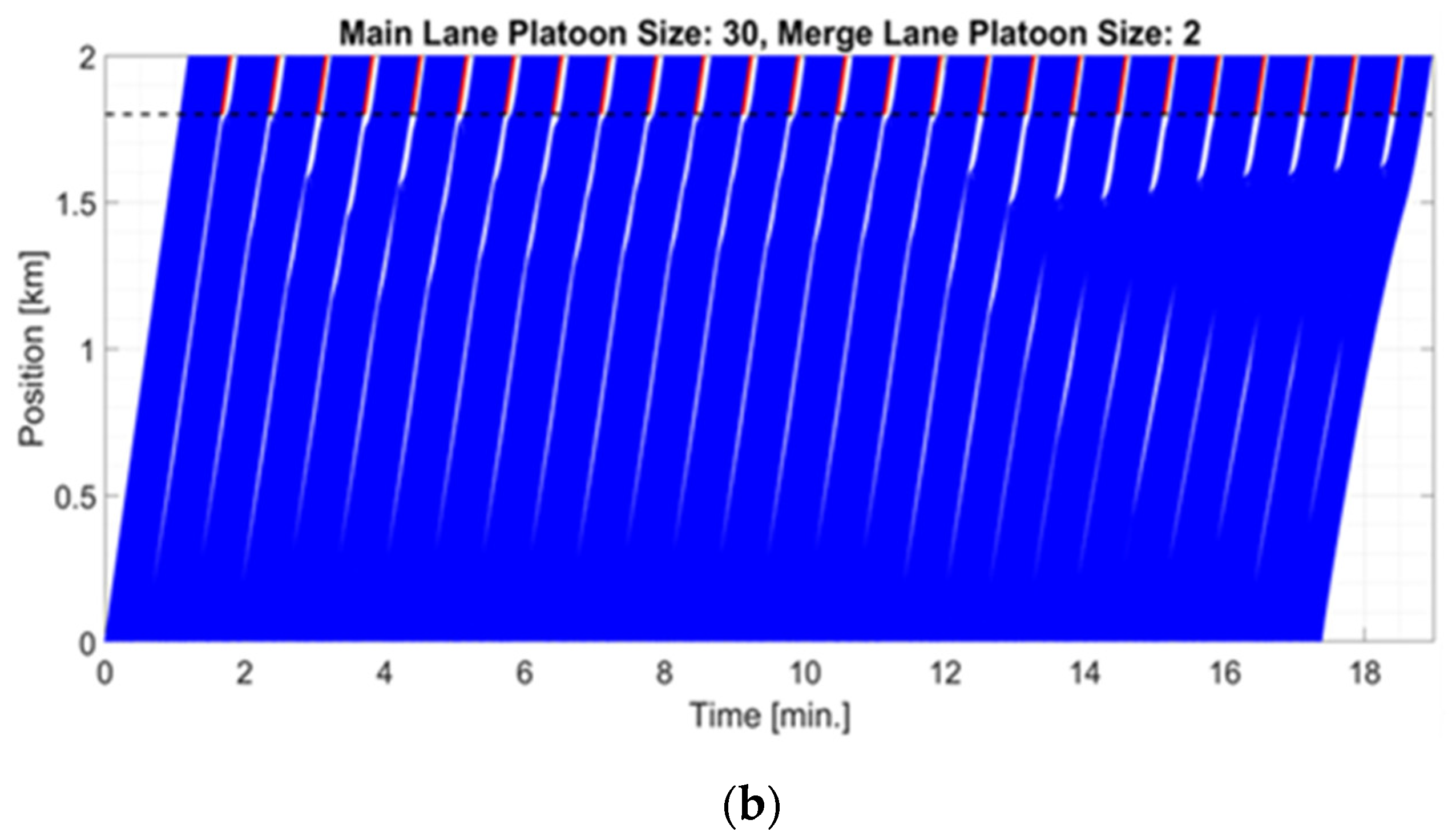
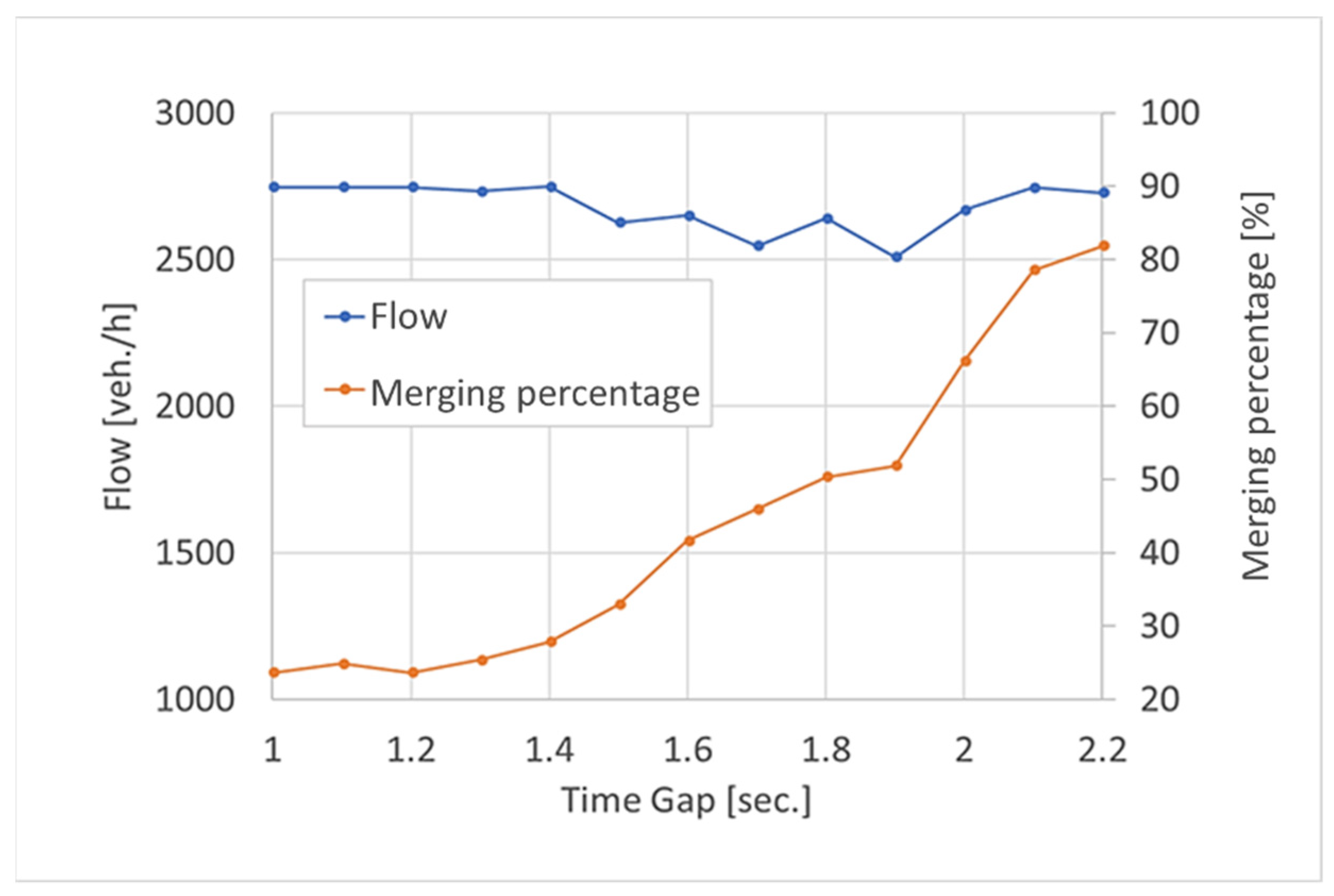

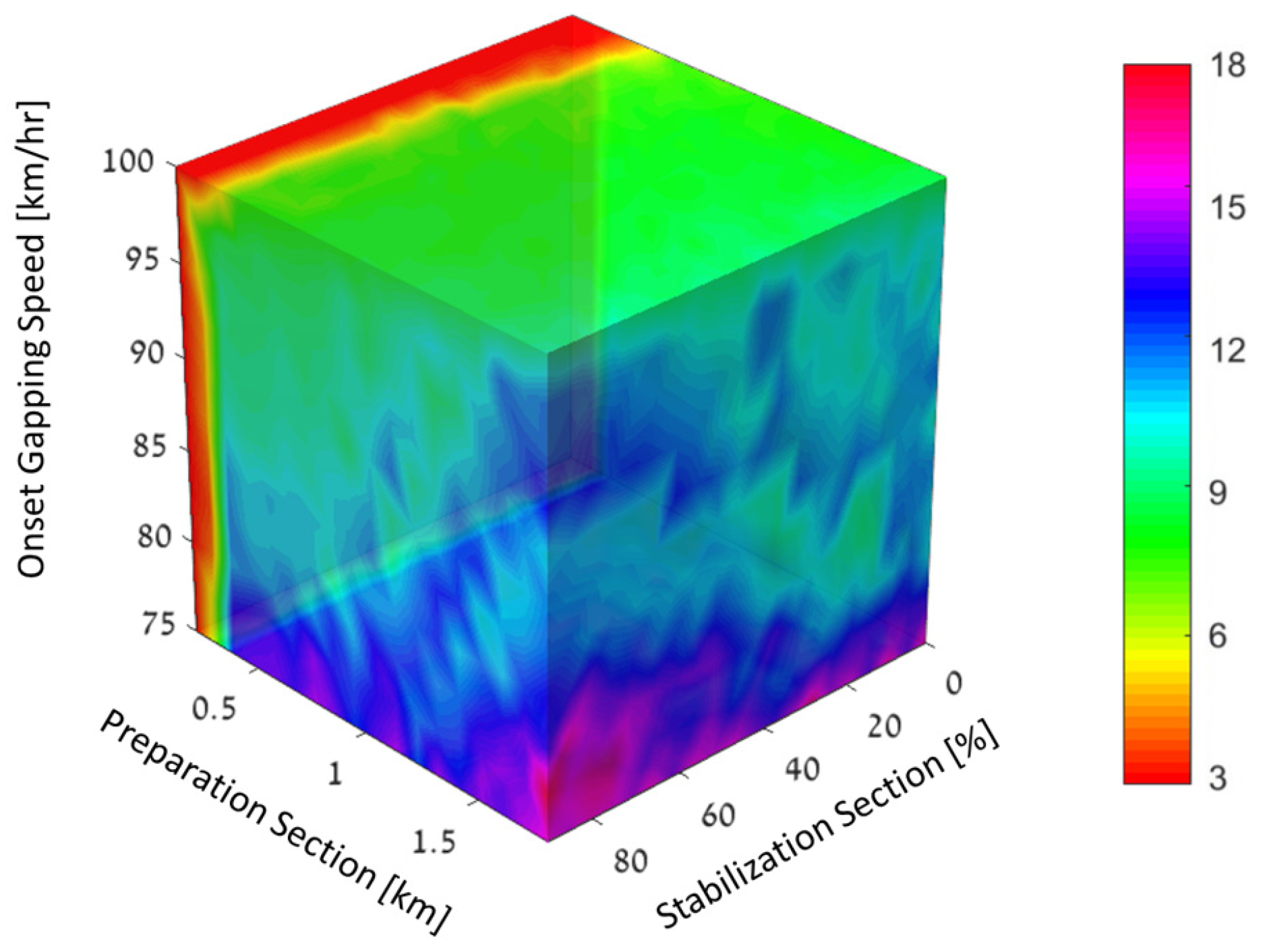
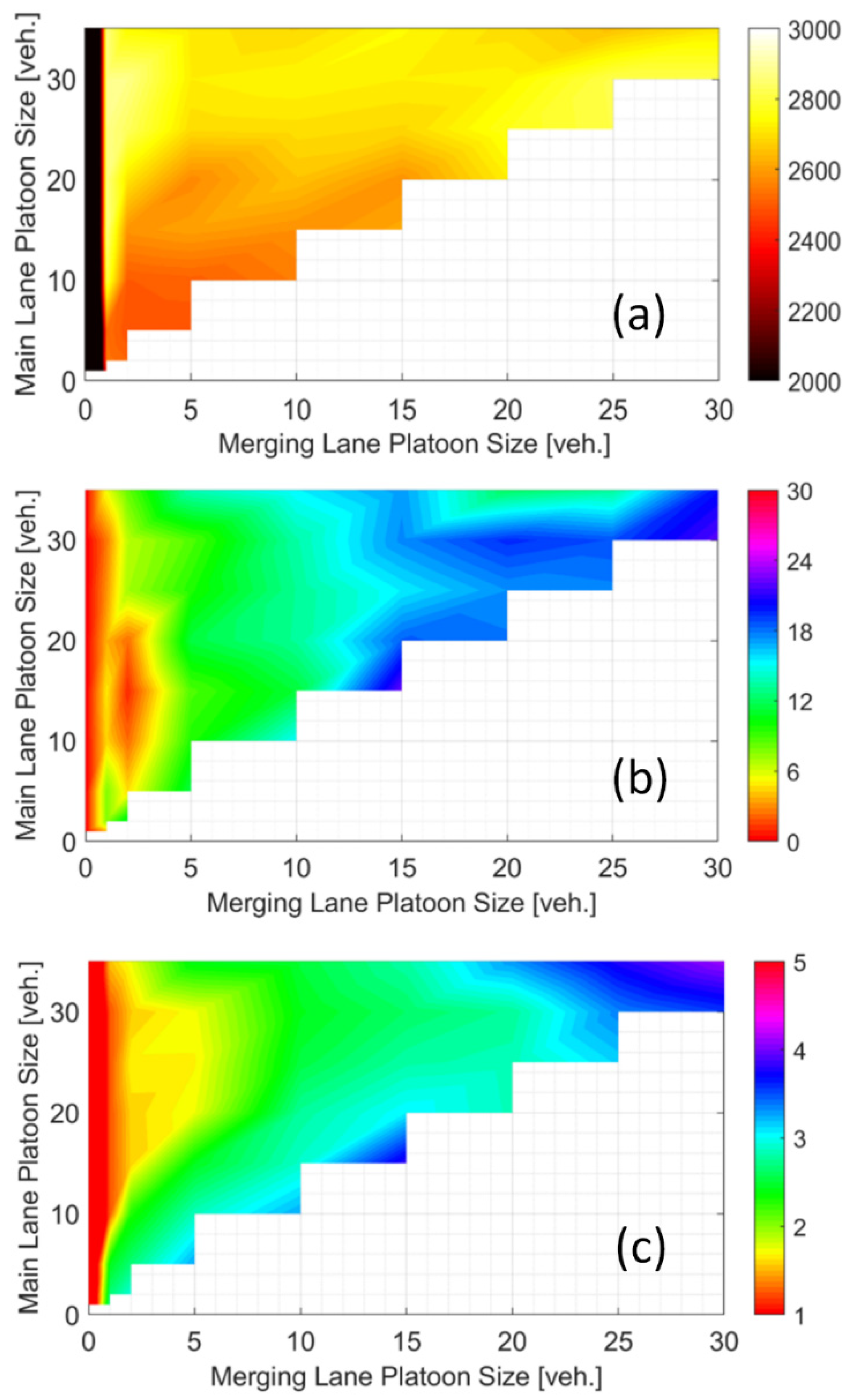
| Parameter | Value | Unit |
|---|---|---|
| Time step Δt | 0.1 | s |
| Road length L | 2 | km |
| Maximal speed | 120 | km/h |
| Maximal acceleration amax | 3.4 | m/s2 |
| Maximal deceleration dmax | 6.86 | m/s2 |
| Vehicle length | 3–6 | m |
| Time gap Tg | 1–2.2 | s |
| Proportional coeff. KP | 0.278 | 1/s2 |
| Differential coeff. KD | 1.667 | 1/s |
Publisher’s Note: MDPI stays neutral with regard to jurisdictional claims in published maps and institutional affiliations. |
© 2022 by the authors. Licensee MDPI, Basel, Switzerland. This article is an open access article distributed under the terms and conditions of the Creative Commons Attribution (CC BY) license (https://creativecommons.org/licenses/by/4.0/).
Share and Cite
Shvalb, N.; Geller, S.; Avrahami, I. Early Gapping and Platoon Merging Strategies for Autonomous Vehicles using Local Controllers. Appl. Sci. 2022, 12, 6328. https://doi.org/10.3390/app12136328
Shvalb N, Geller S, Avrahami I. Early Gapping and Platoon Merging Strategies for Autonomous Vehicles using Local Controllers. Applied Sciences. 2022; 12(13):6328. https://doi.org/10.3390/app12136328
Chicago/Turabian StyleShvalb, Nir, Shlomo Geller, and Idit Avrahami. 2022. "Early Gapping and Platoon Merging Strategies for Autonomous Vehicles using Local Controllers" Applied Sciences 12, no. 13: 6328. https://doi.org/10.3390/app12136328
APA StyleShvalb, N., Geller, S., & Avrahami, I. (2022). Early Gapping and Platoon Merging Strategies for Autonomous Vehicles using Local Controllers. Applied Sciences, 12(13), 6328. https://doi.org/10.3390/app12136328






